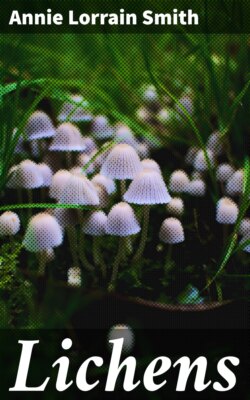Читать книгу Lichens - Annie Lorrain Smith - Страница 63
На сайте Литреса книга снята с продажи.
ОглавлениеFig. 49. Parmelia caperata Ach. (S. H., Photo.).
The felted medulla is characteristic of most lichens and is formed of loose slender branching septate hyphae with thickish walls. This interwoven hyphal texture provides abundant air-spaces.
Hue[359] has noted that the walls of the medullary hyphae in Parmeliae are smooth, unless they have been exposed to great extremes of heat or cold, when they become wrinkled or scaly. They are very thick-walled in Peltigera (Fig. 50).
Fig. 50. Hyphae from lower medulla of Peltigera canina DC. × 600.
b. Lower Cortex. In some foliose lichens such as Peltigera there is no special tissue developed on the under surface. In Lobaria pulmonaria large patches of the under surface are bare, and the medulla is exposed to the outer atmosphere, sheltered only by its position. In some other lichens the lowermost hyphae lie closer together and a kind of felt of almost parallel filaments is formed, generally darker in colour, as in Lecanora lentigera, and in some species of Physcia.
Most frequently however the tissues of the upper cortex are repeated on the lower surface, though differing somewhat in detail. In all of the brown Parmeliae, according to Rosendahl[360], the structure is identical for both cortices, though the upper develops now hairs, now isidia, breathing pores, etc., while the lower produces rhizinae. The amorphous mucilaginous cuticle so often present on the upper surface is absent from the lower, the walls of the latter being often charged instead with dark-brown pigments.
c. Hypothallic Structures. An unusual development of hyphae from the lower cortex occurs in the genera Anzia and Pannoparmelia—both closely related to Parmelia—whereby a loose sponge-like hypothallus of anastomosing reticulate strands is formed. In one of the simpler types, Anzia colpodes, a North American species, the hyphae passing out from the lower medulla become abruptly dark-brown in colour, and are divided into short thick-walled cells. Frequent branching and anastomosis of these hyphae result in the formation of a cushion-like structure about twice the bulk of the thallus. In another species from Australia (A. Japonica) there is a lower cortex, distinct from the medulla, consisting of septate colourless hyphae with thick walls. From these branch out free filaments, similar in structure but dark in colour, which branch and anastomose as in the previous species.
Fig. 51. Pannoparmelia anzioides Darb. Vertical section of thallus and hypothallus. a, cortex; b, gonidial zone; c, medulla; d, lower cortex; e, hypothallus. × ca. 450 (after Darbishire).
In Pannoparmelia the lower cortex and the outgrowths from it are several cells thick; they may be thick-walled as in Anzia, or they may be thin-walled as described and figured by Darbishire[361] in Pannoparmelia anzioides, a species from Tierra del Fuego (Fig. 51). A somewhat dense interwoven felt of hyphae occurs also in certain parts of the under surface of Parmelia physodes[362].
This peculiar structure, regarded as a hypothallus, is probably of service in the retention of moisture. The thick cell-walls in most of the forms suggest some such function.
